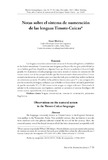| dc.rights.license | http://creativecommons.org/licenses/by-nc-sa/3.0/ve/ | |
| dc.contributor.author | Urban, Matthias | |
| dc.date.accessioned | 2016-01-25T09:14:40Z | |
| dc.date.available | 2016-01-25T09:14:40Z | |
| dc.date.issued | 2015-07 | |
| dc.identifier.issn | 1325-2610 | |
| dc.identifier.uri | http://www.saber.ula.ve/handle/123456789/41463 | |
| dc.description.abstract | Las lenguas conocidas como timote-cuicas en la literatura lingüística se hablaban en los Andes venezolanos. Conocemos estas lenguas que hoy en día con gran probabilidad ya no se hablan, por listas de palabras y algunas frases que fueron recopiladas en fi nes del siglo pasado. En el presente artículo propongo una nueva mirada al sistema de numeración del timote-cuicas, uno de los campos lexicales que fue documentado relativamente bien. Como se notó anteriormente, el sistema opera con base decimal, pero también hay evidencia clara de un subsistema quinario. El análisis de las palabras timote-cuicas para ‘5’ y una comparación con los numerales de lenguas arahuacas que se hablan en la vecindad indican la posibilidad de que las numerales ‘4’ y ‘5’ del timote-cuicas tengan un origen arahuaco. Discutiendo la calidad de la evidencia para esta hipótesis, también se considera el sistema fonológico del timote-cuicas, especialmente de la acentuación. | es_VE |
| dc.language.iso | es | es_VE |
| dc.rights | info:eu-repo/semantics/openAccess | |
| dc.subject | Lenguas timote-cuicas | es_VE |
| dc.subject | Sistema de numeración | es_VE |
| dc.subject | Préstamos lingüísticos | es_VE |
| dc.title | Notas sobre el sistema de numeración de las lenguas Timote-Cuicas | es_VE |
| dc.title.alternative | Observations on the numeral system in the Timote-Cuicas languages | es_VE |
| dc.type | info:eu-repo/semantics/article | |
| dc.description.abstract1 | The languages commonly known as Timote-Cuicas in the linguistic literature, were spoken in the Venezuelan Andes. Now probably extinct, they are known to us only from wordlists and a few phrases collected around the turn of the last century. Here, the numeral system, one of the lexical domains which has been documented comparably well, is reconsidered. As has been noted before, the system operates on a decimal basis. However, there is more to be learned: there is clear evidence of a pentad oriented subsystem, and analysis of the Timote-Cuicas words for ‘5’ and a comparison with the numerals of neighbouring Arawak languages indicates the possibility that the Timote-Cuicas numerals for ‘4’ and ‘5’ have an Arawak source. In the discussion of the quality of the evidence for this hypothesis, observations on the phonological system of Timote-Cuicas, particularly regarding stress, will be made as well. | es_VE |
| dc.description.colacion | 53-69 | es_VE |
| dc.description.email | m.urban@hum.leidenuniv.nl | es_VE |
| dc.description.frecuencia | Semestral | |
| dc.identifier.depositolegal | ppi201403ME788 | |
| dc.publisher.pais | Venezuela | es_VE |
| dc.subject.centroinvestigacion | Centro de Investigaciones Etnológicas (CIET) | |
| dc.subject.dependencia | Museo Arqueológico "Gonzalo Rincón Gutiérrez" | es_VE |
| dc.subject.keywords | Timote-Cuicas languages | es_VE |
| dc.subject.keywords | Numeral system | es_VE |
| dc.subject.keywords | Loanwords | es_VE |
| dc.subject.publicacionelectronica | Boletín Antropológico | |
| dc.subject.seccion | Boletín Antropológico: Artículos | es_VE |
| dc.subject.thematiccategory | Artes y Humanidades | es_VE |
| dc.subject.tipo | Revistas | es_VE |
| dc.type.media | Texto | es_VE |


